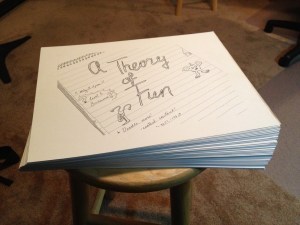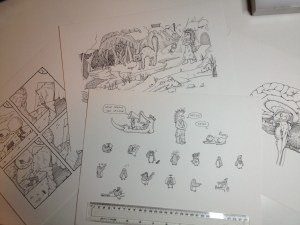Update #1 on revised Theory of Fun


 So, the revised edition of A Theory of Fun is indeed in process. I thought I would post an update for everyone.
So, the revised edition of A Theory of Fun is indeed in process. I thought I would post an update for everyone.
Where we are
I have been going back and forth with the publisher on what exactly needs to be revised. I have my own list, and I was hoping that the revisions would be shaped by responses from people as to things they disagreed with or have changed over time. I haven’t gotten a lot of those, alas… many thanks to those who have sent in stuff!
The reason this matters now, before any writing actually starts, is in order to set schedules for milestones. That said, I fully expect the coloring of all the artwork to take far longer than the text revision.
One thing that I have gotten as a vibe overall is “don’t break it.” Meaning, don’t change it too much or revise it to the point where it loses the qualities that make it what it is.
One big example of this that has come up and is still up in the air is the layout format of the book. As you know, it’s a non-standard trim size, wider than it is tall, and famously fits poorly on many bookshelves. I ran an informal poll on Twitter, and got very split results as to whether to change that. One of the biggest reasons in favor is that if it changes to a standard trim size, it cam move to print-on-demand in the book supply chain, and then it’ll tend to never fall out of print the way that it has in the past. Right now, when copies run out, the print run needs to be manually ordered. Plus, ebook versions mean that the layout aspect has already been somewhat lost. But a lot of folks seem to have great affection for what has been called “a bastard form of a picture book” … so we’ll see!
What’s done
Last weekend, I gathered up the final printed black and white cartoon images to look at what is involved in coloring them. They were all flattened, with the captions on them, in black and white. To color them, I really needed them to be transparent with line work, so I can paint behind them on another layer. The cartoons were in fact Photoshop files at one point (they all had the captions overlaid by me in Photoshop after all) but it looks like I cleared away the Photoshop files ages ago to save on disk space (many many gigs of it, back when gigs mattered) and I cannot locate a CD backup.
No worries — it took a few hours, but I got a Photoshop action done that takes the cartoons as printed, carefully grabs just the line work (with the grayscale and rough edges and the rest preserved, since it was all done by hand on Bristol board), and moves them onto a transparent layer. The old fashioned Magic Wand wouldn’t work, because I would lose the correct shape of the line. So now I have 5 gigabytes worth of cartoons ready to be colored.
For actually coloring, I hoped to do it on the iPad. Alas, there are no iPad apps that will open the PSD files. Photoshop Touch flattens them unless you use CS5 — I’m still on CS2! — and they fail to open on Sketchbook Pro and other apps. I would have done it on my old Tablet PC, except, well, the screen died. My old Wacom tablet has been obsolesced, and no longer even connects (serial port, ha!). Lastly, I have a Tablet PC for my job, but I can’t use company resources for this project.
So I have borrowed my daughter’s Bamboo tablet… and had to order a new pen for that, too, since she lost the first one. No sooner did I get it working than she took it back again… That said, I really miss not seeing what I am doing on the screen. (Hmm, those Windows Surface Pro tablets are coming out really soon…)
What’s next
The publisher and I should be agreeing on a schedule in the next week or so, and then I start coloring!
I also need to figure out what new material is going in the book — not so I can write it, but so that I can do cartoons for it. I am currently expecting to add a couple of pages within existing chapters, and if I do that, I am planning on doing those new cartoons in the same style, with the same tools, as last time. All in all, I expect there to be around the equivalent of 120 pages of cartoons to be colored, counting the new ones.
I also am going to take all the baked captions off of the cartoons, and replace them. We have hopes that perhaps some new translations will happen, and if so, it’ll make everyone’s life easier if the captions are not baked into the artwork. A while I ago I made some fonts of my handwriting that are similar to that in the cartoons (you can see those throughout the “10 Years Later” deck) and I will probably use those so that there is minimal change to the appearance of the cartoons.
In practice, only a couple of people have sent in the sort of detailed notes that I needed. If you want to help out, I could sure use the assistance still! Even small snippets or quibbles are enormously useful. I outlined what sort of thing I was looking for in the original post about it, but here’s a couple of anonymized examples of the stuff that people have sent in, so you can see what sort of help I am looking for.
Media violence note: I may be the 200th person to mention this, but you should include this study: http://www.international.ucla.edu/cms/files/dahl_dellaviga.pdf in the notes about the effects of media on violence. You may also want to address self-incapacitation and other ways in which violent media can reduce violent crime in the main text
or
If “Counter-Strike” is about teaching teamwork, why do people still play it after 5 years or more? What more teamwork – or indeed anything – is there to learn? Are they still having fun? If so, how does their kind of fun fit into your theory?
or
You talk about story in games as if it was all narrative arcs. There are different types of story, and the narrative arc is not the most important one: that’s the player’s OWN story, that they constructed from the events they experienced while playing through the game. A narrative arc is a way of pre-generating causal events that the designer feels the player will like, but it’s not the arc that’s important per se, it’s the experiencing of it through play.



